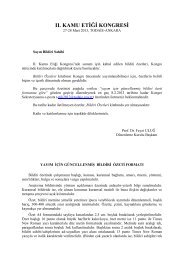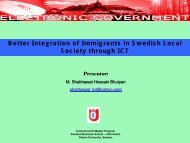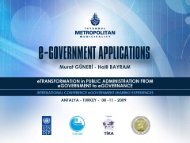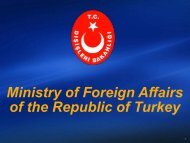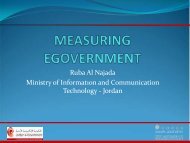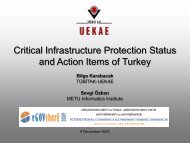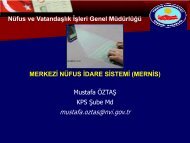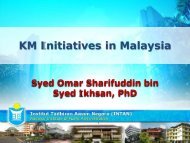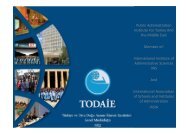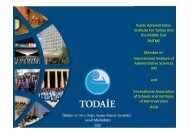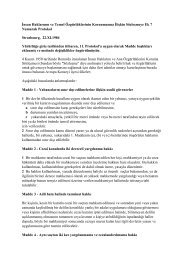Nitin Nagpal
Nitin Nagpal
Nitin Nagpal
- No tags were found...
Create successful ePaper yourself
Turn your PDF publications into a flip-book with our unique Google optimized e-Paper software.
m-GOVERNMENTINDEVELOPING COUNTRIES: LEVERAGINGMOBILE TECHNOLOGYTOENABLE BETTER GOVERNANCEDecember 10, 2009eGOVsharE2009
AgendaWhy m-Government?What is the progress?How to implement?What are the limitations?How to evaluate?eGOVsharE2009
The changing landscape…raises two questions?1So what is changing?2How to leverage thischange?Photograph Source: http://sampada.net/Note: m-Government is not a subset of e-Government but an extension whichcompliments the existing initiativeseGOVsharE2009Page 3
Current Scenario in developing countries1 Digital divide is a serious concern2 Mobile phone penetration much higher than internet penetration3 Even illiterates are using mobile phones4Rural population is higher than urban population and is still beyond thereach of e-Government5 Low health and education services for rural populationm-Government intends to leverage the reach of mobile phones forpublic service deliveryContinued need for “Citizen Centricity”eGOVsharE2009Page 4
Why m-Government?What is the progress?How to implement?What are the limitations?How to evaluate?eGOVsharE2009
Case of Bahrain… Enablement of Public Services through mobile (Bahrain). The concept behind the mobile service is“Serve on the move”.Mobile Portal: www.bahrain.bh/mobile National SMS: 4949 Batelco, 88311 for Zain users The mobile channel of the Kingdom went live on the 25th of May 2009 with over 15 services. Currentlywe have 25 services on the mobile. The channel will host 50 key services of various ministries by theend of 2009, and will include payment services as well. Mobile services are categorized into 3 groups(a) Informational services --> Flight information, Currency Convertor, etc.(b) Transactional services --> Check you blood record, tracking of postal packages, graduateexamination results, etc.(c) Payment services (still under development) --> Electricity Bill payment, traffic contravention, etc...payment will be through credit card. Card details will be stored in the database. The eGovernment Authority (nodal agency in Bahrain that is responsible for eGov StrategyImplementation) has developed an Bulk SMS Gateway through which all Government entitles can sendtheir SMSs utilizing the bulk SMS packages offered by the telcos. All services are available in Arabic as well as English languages. SMS Short codes are also available onthe above link for the users. Also, plans to have Mobile 2.0 initiatives such as providing blogs (on WAP),online survey / online Polls through WAP & SMS.eGOVsharE2009Page 6
Case of India1 Around 54 gram panchayats in West Bengal in five remote blocks of the stateare in process to have SMS alerts on disasters, funds inflow and outflow,information about health camps and pulse polio campaigns information andother communication between will be sent to and from between the statedepartments, district offices and gram panchayats, block development offices.2 Dr. SMS – a SMS based m-Health Information System for Kozhikode District(Kerela, India)eGOVsharE2009Page 7
Why m-Government?What is the progress?How to implement?What are the limitations?How to evaluate?eGOVsharE2009
Implementation Model for m-Government initiativesBuildingblocksPillarsFacetsInvestmentPPPPublic Private Partnershipm-Governmentm-Service m-Participationm-Voting m-InformationReengineer processEducate citizenListen to citizenEngage citizenLocalized contentICT Infrastructure developmentProvision of legal and institutional frameworkSecurity / Identity managementTechnologyInvestmentManpowerInvestmentMarketing /PromotionCapacityBuildingEnhanced model for data ownershipeGOVsharE2009Page 9
Why m-Government?What is the progress?How to implement?What are the limitations?How to evaluate?eGOVsharE2009
Key Limitations / ChallengesInformationExchange SizeThe limitation of mobile phone in context of small screenand limited text input restricts the amount of information thatis sent and received.ContentLack of local content is an obstacle to implementation ofsuch initiatives.SupportingStructureInstitutional and Financial structures are not in place insome of the developing countries to support m-Governmentinitiatives,eGOVsharE2009Page 11
Why m-Government?What is the progress?How to implement?What are the limitations?How to evaluate?eGOVsharE2009
Evaluating Engagement and EffectivenessMeasuring citizenengagement and impact Cost saving for citizen Waiting time reduction forcitizen Man-hours saved forgovernment officials Number of users of theservice Percentage increase in thenumber of service usersEvaluateMeasuring effectiveness Accessibility of application Extent to which core purposewas served by application User interface, navigationand organization Error free service delivery Relevance and legitimacy Social acceptability in termsof trust and securityeGOVsharE2009Page 13
“If one considers government services to be 100%, 1-5% willstill require a visit to the Government office, around 30-40%will be available through the Citizen Service Center (CSC) orgovernment service delivery centers and 50-60% could beprovisioned on the mobile devices."Mr. R. ChandrashekharSecretary, e-Governance,Ministry of Communication and Informationtechnologies, Government of India.eGOVsharE2009
Thank you!<strong>Nitin</strong> <strong>Nagpal</strong>Managing Consultant, PricewaterhouseCoopers, IndiaE-mail: nitin.nagpal@in.pwc.inSaurabh AgarwalSenior Consultant, PricewaterhouseCoopers, IndiaE-mail: saurabh1.agarwal@in.pwc.ineGOVsharE2009



